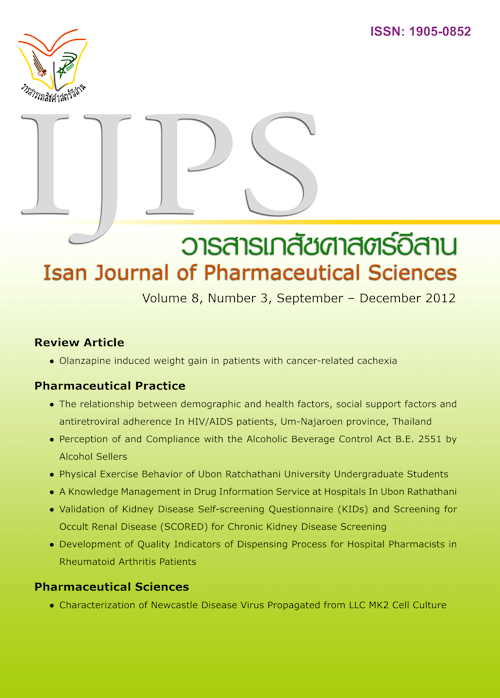Physical Exercise Behavior of Ubon Ratchathani University Undergraduate Students
Main Article Content
Abstract
Introduction: Optimal physical exercise increases both physical and mental health. The objectives ofthis cross-sectional survey were to estimate the rate of physical exercise, identify physical exercise behaviors andfactors infl uencing exercise behaviors of Ubon Ratchathani University (UBU) undergraduate students. Methods:Actively enrolled undergraduate students in academic year 2009 were randomly selected from the registry bymultistage sampling. Questionnaire was initially developed from the American Association of Sports Medicine’scriteria and previous research in Thailand. The questionnaire was reviewed by experts, tested and revised for the fi nalversion which comprised 4 parts: (1) demographic data, (2) intention to exercise, (3) stress level, and (4) physicalexercise behavior score. Physical exercise behaviors were analyzed by descriptive statistics. Factors associatedwith exercise behaviors were analyzed by multiple regression analysis. Results: The results showed that most ofthe 389 UBU students performed exercise over 30 minutes per session. The majority, however, performed physicalexercise less than three times a week. Most students warmed up and cooled down for 5-10 minutes; nevertheless,41.4% and 47.0% warmed up and cooled down less than 5 minutes respectively. More importantly, 32.1%of students felt very exhausted but they were still able to talk or couldn’t talk to others after performing exercisefor 15-30 minutes. Statistically signifi cant factors associated with exercise behavior score were: (1) intention toexercise, (2) stress level, and (3) body mass index less than 18.5 (p<0.05). Intention to exercise was the strongestpredictor of exercise behavior score (β=1.99, p<0.05). All signifi cant predictors explained 26.6% (R2) of exercisebehavior score variance. Conclusion: Some UBU students performed physical exercise inappropriately. Intentionto exercise, stress level and body mass index less than 18.5 kg/m2 were signifi cant predictors of physical exercisescores. UBU should implement an additional policy to help students perform physical exercise appropriately toachieve the physical exercise goals.
Article Details
In the case that some parts are used by others The author must Confirm that obtaining permission to use some of the original authors. And must attach evidence That the permission has been included
References
Advisory Department of Health. Ministry of Public Health Thailand. Exercise Policy for Health Promotion.2009 [cited 2009 Sep 19]; Available from: http://advisor.anamai.moph.go.th/hph/letter02/policy.html.
Anonymous. ACSM cardiorespiratory training guidelines. 2010 [cited 2010 Sep 19]; Available from: http://athletics.spokane.edu/getdoc/54d93fd5-4d91-4e30-97d8-3e70e91fc07e/ACSMTrain-ingGuide.aspx.
Department of Mental Health. Ministry of Public Health Thai-land. Self-Assessment of Stress. Department of Mental Health and Community Psychiatry, Sakaew Ratchanakarin Psychiatric Hospi-tal2008 [cited 2009 Sep 19]; Available from: http://www.dmhweb.dmh.go.th/jvsk/cpsy2/Exam5.htm.
DiPiro JT. Making the most of pharmacy school. Am J Pharm Educ 2008 15; 72(1): 15.
Garber CE, Allsworth JE, Marcus BH, et al. Correlates of the stages of change for physical activity in a population survey. Am J Public Health 2008; 98(5): 897-904.
Haskell WL, Lee IM, Pate RR, et al. Physical activity and public health: updated recommendation for adults from the American College of Sports Medicine and the American Heart Association. Circulation 2007; 116(9): 1081-93.
Jomkokkruad N. The Study of Physical Exercise and Sporing Behaviors of Students in Rajamangala Univeristy of Technology Isan, NortheasternCampus, Nakhonratchasima [Thesis]. Khonkaen: Khonkaen University; 2007.
Kaplan DS, Liu RX, Kaplan HB. School related stress in early adolescence and academic performance three years later: the conditional infl uence of self expectations. Soc Psychol Educ 2005; 8(1): 3-17.
Kelley K, Maxwell SE. Sample size for multiple regression: obtaining regression coefficients that are accurate, not simply significant. Psychol Methods 2003; 8(3): 305-21.
Knofczynski GT, Mundfrom D. Sample Sizes When Using Multiple Linear Regression for Prediction. Educational and Psychological Measurement 2008 June 1, 2008; 68(3): 431-42.
Kulthanan T, Soparat K, Junhom N. Physical fi tness and physical activities profiles of second-year medical student: Faculty of Medicine Siriraj Hospital, Mahidol University. Siriraj Med J 2001; 53(11): 797-804.
Lemon SC, Rosal MC, Zapka J, et al. Contributions of weight perceptions to weight loss attempts: differences by body mass index and gender. Body Image. [Multicenter Study Randomized Controlled Trial] 2009; 6(2): 90-6.
Narin J, Taravut T, Sangkoumnerd T, et al. Prevalence and factors associated with sufficient physical activity among medical students in Khon Kaen University. Srinagrarind Medical Journal 2007; 24(4): 389-95.
Plotnikoff RC, Lubans DR, Costigan SA, et al. A test of the theory of planned behavior to explain physical activity in a large population sample of adolescents from Alberta, Canada. J Adolesc Health 2011; 49(5): 547-9.
Stephan K, McClure R, Seubsman SA, et al. Review of injuries over a one year period among 87,134 adults studying at an open university in Thailand. Southeast Asian J Trop Med Public Health 2010; 41(5): 1220-30.
Sumkaew J. Physical exercise behaviors for health of nursing students in Bangkok Metropolis [Thesis]. Bangkok: Chulalongkorn University; 2002.


